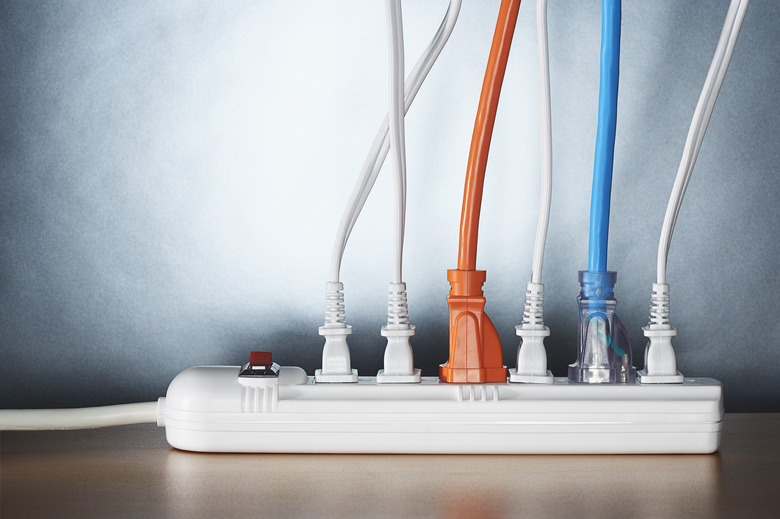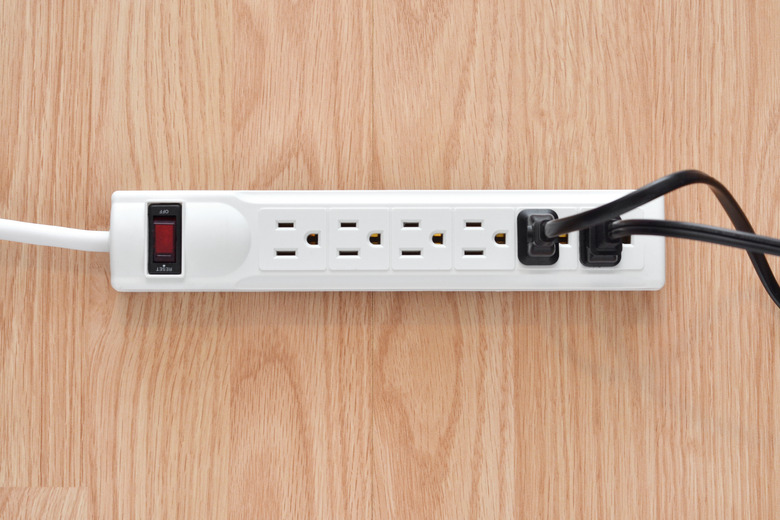What Is A Surge Protector, And Where Do I Need One?
We may receive a commission on purchases made from links.
A surge protector is like insurance: 99.9 percent of the time, you don't need it, but that 0.1 percent of the time that you do, you'll be glad you have it. Surge protectors help protect your plugged-in items from potential harm in the event that too much electricity surges through your home's wiring due to a lightning strike or other source. Surges can even be caused by some of your own appliances.
Tip
A surge protector helps protect electronics from extreme power spikes. Use one in any grounded outlet to protect expensive electronics.
Why Power Surges Happen
Why Power Surges Happen
A power surge — or a similar effect called a power spike — happens any time the voltage flowing through your home's electrical lines greatly exceeds the usual amount, which averages 120 volts for most wiring and outlets in the typical home in the United States. Lightning strikes on nearby circuits or power lines are one well-known cause of power surges and spikes. These are often the most extreme type of spike, but they're not all that common.
Major appliances, like a refrigerator, freezer or air conditioner, may also cause power surges because their components, such as fans and compressors, cycle on and off. In some cases, the power company itself may inadvertently cause a surge that affects your home as it switches power between electrical grids or performs other maintenance.
Household voltage often fluctuates a little above and below the standard 120 volts, but in most cases, this happens unnoticed and without negatively affecting anything plugged into the home's outlets. Minor bursts slightly above 120 volts generally aren't enough to damage delicate electrical and electronic components, although even an extra 100 volts is enough to cause harm, which you may have noticed if you've ever plugged a 120-volt item into an improperly functioning power converter in Europe, which has a much higher voltage standard.
The main difference between a power surge and a power spike is that a spike lasts up to three nanoseconds, while a surge lasts longer, even if the total voltage spike is still less than a second. Spikes or surges not related to weather sometimes happen so fast that you may not know anything happened at first even though these extreme voltage events are capable of burning or "frying" the wiring and other components within common plug-in items, such as a computer or TV.
How Surges Affect Plugged-In Items
How Surges Affect Plugged-In Items
A power surge or spike introduces an excessive amount of voltage to an item that's not designed to tolerate such amounts. It's a bit like trying to heat up some leftovers in a blast furnace instead of in a low-temperature home oven: Not only will the extreme heat destroy the food and make it inedible but there's a good chance the pan or vessel you used to hold the food will also be damaged in irreparable ways.
Electricity traveling through materials generates heat, as you may have noticed if you've ever touched a plugged-in laptop power supply or even the bottom of your laptop while it's in use. Extreme voltage creates enough heat to melt the coating on electrical wires as well as solder and other components within an electronic device that's plugged into an outlet. A lightning strike, capable of producing millions of volts, may even scorch the area around an outlet and melt part of the outlet cover. It's commonplace for at least some electronic items to stop working properly if the home is affected by a lightning strike.
Surge Protector Basics
Surge Protector Basics
A surge protector, or surge suppressor, offers some protection but not complete protection for electrical devices plugged into it as long as it's plugged into a grounded outlet. The surge protector detects excessive voltage immediately and redirects it through the ground wiring so those extra volts don't travel into your devices that can't handle high voltage. The higher the joule rating on the surge protector, the more energy it's capable of handling, which means the better it is at handling power surges. For expensive electronics, such as a TV, game console or computer, a rating of 2,000 joules or more is a good idea, while 1,000 joules is often enough for basic electronic and electric goods, such as a blender, toaster or lamp.
Though some surge protectors look a bit like power strips and allow multiple items to be plugged in at once, a regular power strip does not protect against power surges. This is true even if the power strip has a built-in circuit breaker. The most useful surge protectors offer plenty of outlets to plug in your valuable electronics. If your electronic items have boxy power supplies or "wall warts" that typically block nearby wall outlets when plugged in, look for a surge protector that offers more space between outlets so you have room to plug in everything.
Over time, a surge protector degrades and eventually loses its ability to offer much protection, especially after it's been through a surge or two. If you aren't sure whether your surge protector still works properly or if you've used it continuously for more than a few years, it's a good idea to replace it.
Whole-House Surge Protectors
Whole-House Surge Protectors
While the common plug-in style of surge protector is readily available at big-box electronics stores and requires no special skills to get it up and running, a whole-house surge protector often requires professional installation. These require proper grounding and are usually hardwired to the main service panel, or breaker box, in a home and to the home's grounding system. Whole-house surge protectors offer surge protection for anything connected to the breaker box — that is, the home's entire electrical system. They're quite useful for high-tech washers and dryers and similar items that normally might not be hooked up to a plug-in surge protector.
The higher the amperage rating, the more protection the whole-house surge protector offers. Look for a protector rated to handle at least a 40,000-amp surge and for any type of light or indicator that lets you know when it has been affected by a surge. Ask your electrician about different options to determine what's right for your home.
But even a whole-house surge protector doesn't protect against every surge. It still allows a small amount of excess voltage to pass through the home's wiring when a surge happens, so adding a plug-in surge protector is still a good idea for your home theater setup or your computer peripherals — essentially anything with electronic circuits that would be expensive to repair or replace.

